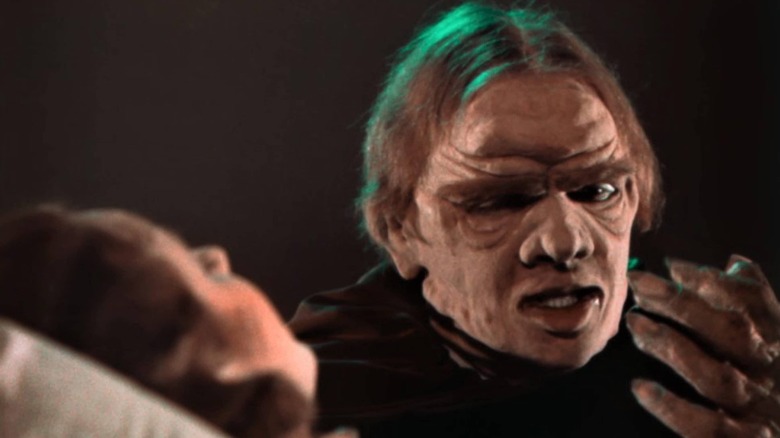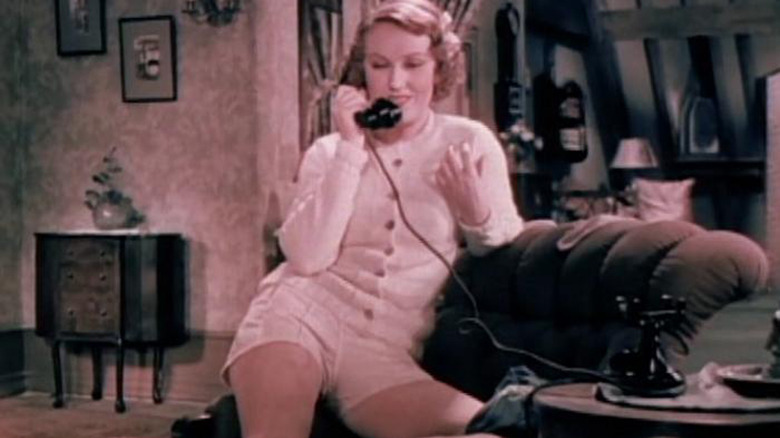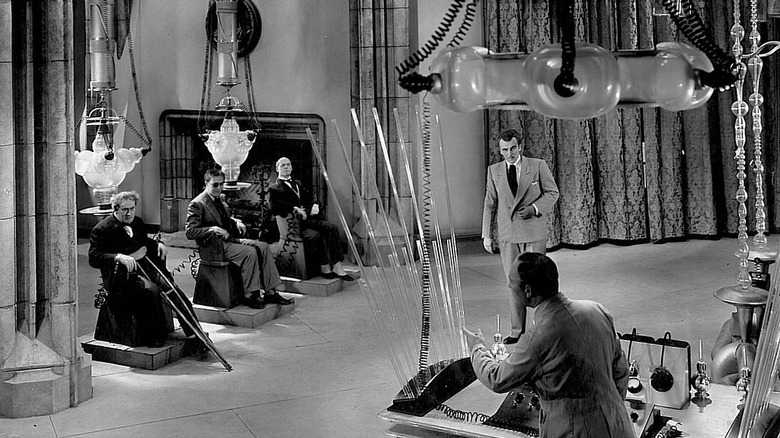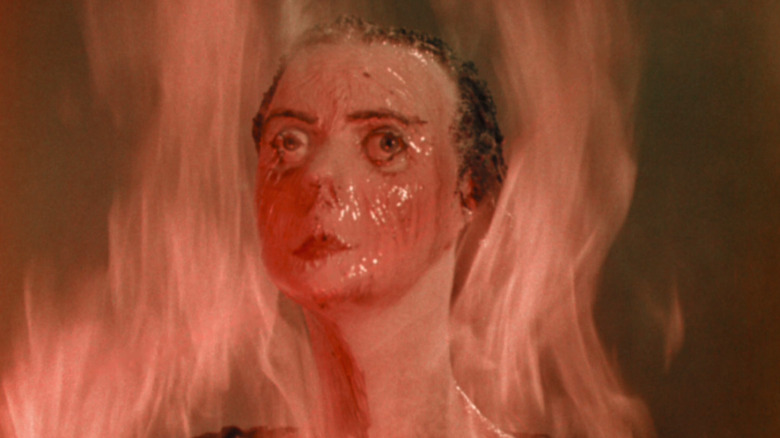Doctor X Is An Insane Pre-Code Technicolor Horror Blast And It's Streaming Now
We may receive a commission on purchases made from links.
Right now, the Turner Classic Movies streaming app Watch TCM is featuring two classic pre-code horror movies made by director Michael Curtiz for Warner Bros. That's right, the great "Casablanca" helmer dabbled in horror in the early 1930's when producer Darryl F. Zanuck and WB (back when it was run by the actual B's) decided to cash in on the popular horror trend kicked off by Universal Pictures' "Dracula" and "Frankenstein" in 1931. So in 1932 they hired studio journeyman Curtiz to make "Doctor X," a mad scientist-themed picture starring noted Hollywood B-movie star — and sometimes orgy master — Lionel Atwill ("Frankenstein Meets the Wolf Man") as well as Fay Wray, she of the loud screams in "King Kong."
Made on a budget of around $200,000 dollars, "Doctor X" was such a success that WB immediately followed it up with 1933's chiller "Mystery of the Wax Museum," re-teaming Curtiz with Atwill and Wray, and once again filmed in gloriously vibrant two-strip Technicolor. With both films now on the streaming service, let's take a look back at both — particularly "Doctor X" — and why they're so startling to watch in 2021.
Why the Pre-Code Status is So Significant
"Pre-code Hollywood" refers to that brief, beautiful window between 1929 and 1934 when studios were not strictly enforcing the Motion Picture Production Code/Hays Code, and you would see more adult content and themes in studio pictures before the Production Code Administration came in and began castrating movies. Because it was made during this window, "Doctor X" has more teeth than you're used to seeing in a classic horror picture, and coupled with its color look, it feels surprisingly contemporary.
The plot involves a snoopy alcoholic reporter played by Lee Tracy who is looking into a series of "full moon murders" being committed by a serial killer witnesses say is a disfigured monster. These murders seem to involve the killer cannibalizing the victims, as detailed during an autopsy scene. There is mention of prostitution, rape, drug addiction and a final scene before the credits role involving a "joy buzzer" that can really only be interpreted in a lascivious way.
There is a particular scene where we're introduced to the eye-patched Dr. Rowitz (Arthur Edmund Carewe) with his white lab coat speckled in red blood. This was probably the first time audiences were exposed to blood in color, decades before Hammer Studios made a mint dumping globs of bright red paint all over the screen in their Christopher Lee/Peter Cushing "Frankenstein" and "Dracula" movies.
"Mystery of the Wax Museum" is also loaded with innuendo and "offensive" material, including Fay Wray posing suggestively in a scene where she chats on the phone. Her roommate is a motormouthed reporter named Florence played by the hilarious Glenda Farrell, who at one point in the film walks up to a cop and bluntly asks him, "How's your sex life?" One of the main characters is a junkie (we see him get drugs in shadow at one point) who the cops let dry out until he finally agrees to confess to a crime, telltale dark circles over his eyes.
The Horror Movie So Nice They Made It Twice
"Doctor X' and "Mystery of the Wax Museum" hold the distinction of being the first horror films produced in color, but that wasn't necessarily what the studio wanted. Around 1932, the popularity of the color musicals being released was waning, and WB was hesitant to make films that way but still had a two-picture commitment with Technicolor. They even asked if they could fulfill their commitment with two shorts instead of features.
Instead, they decided to film these two "quickie" B-movies in the two-strip process (also known as Process 3). They were so adamant against the color version (shot by Ray Rennahan) that they actually had Curtiz shoot an alternate version of "Doctor X" in black & white with a different director of photography, Richard Tower. This non-color version of the film actually got a wider release, with the Technicolor version only going to the major markets in big cities. It's a shame, because the color version shown on TCM (from UCLA's 2020 4K restoration funded by George Lucas) is a candy-coated marvel, with expressive use of green gels that prefigure the highly stylized Italian horror of Mario Bava and Dario Argento.
The black & white cut is mostly similar takes to the color one, with a few minor ad-libs, but the German expressionist compositions are far weaker. The color is one of the main things that distinguishes "Doctor X" from the myriad other monochromatic mad scientist movies of the era, many of which also featured Atwill, like Universal's 1942 "Night Monster." For decades, the only version available to the public and in TV syndication was the black & white cut, or to make matters confusing, the color version transferred to black & white. Technicolor had discarded most of their two-color negatives in 1948, but upon Jack Warner's death in 1978, a nitrate film print of the color version was miraculously uncovered among his collection.
A Spiritual Sequel?
"Doctor X" has so many insane things in it, not least of which when the serial killer is finally revealed to be altering his appearance with "synthetic flesh" that he globs onto his face like putty. That scene and his ultimate demise (being lit on fire and tossed out a castle window with his cooking corpse splatting on the rocks below) make this feel like an early stab at something like Sam Raimi's "Darkman." All the Tesla coil art direction adds to the atmosphere, which builds to a climax involving several scientists handcuffed to chairs while they watch a woman about to be murdered.
The spiritual follow-up "Mystery of the Wax Museum" was perhaps even more influential.The plot follows a fine wax statue artist played by Atwill whose life's work is destroyed by a sleazy investor for a quick insurance payout, only for him to then rebuild his gallery with real bodies in order to take revenge. We of course saw this story ported over nearly wholesale for the 1953 Vincent Price joint "House of Wax," and the conceit of using real bodies to create "art" has been used in films like Roger Corman's "Bucket of Blood" and Giorgio Ferroni's criminally underseen "Mill of the Stone Women."
The scene where Wray sees Atwill's wax facade face crumble to reveal the horrifying disfigurement underneath was recycled for a memorable moment in David Cronenberg's "The Fly." We've also seen the masked disfigured protagonist in Price's "Doctor Phibes" movies as well as the recent "The Cure For Wellness."
Definitely check out both of these movies right now on the TCM app before they're gone, or purchase them on two beautiful Warner Archive Blu-rays released this past year.



